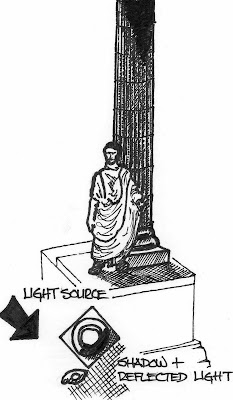roadking
A Fixture
 The focus of this post will be on the prep work for the base on this figure as it is such an integral part of the entire piece. This is really always the case on any miniature but especially here as it will set the tone for the lighting and mood of the final piece. I began by cutting a thick piece of styrene plastic to the same size as the wooden base that I will be using. This was then trimmed diagonally along the back to replicate a portion of the steps up into the Roman senate building. The Bayardi column was then attached with Cyano and lines for the marble sections scribed into the plastic along with the locating holes for the figure. A pin is drilled into the column for mounting strength as well as to attach the groundwork to a balsa working base/block. This gives me something to hold onto while painting other than the final base. The final base is lacquered black ash and I have no desire to mar that surface.
The focus of this post will be on the prep work for the base on this figure as it is such an integral part of the entire piece. This is really always the case on any miniature but especially here as it will set the tone for the lighting and mood of the final piece. I began by cutting a thick piece of styrene plastic to the same size as the wooden base that I will be using. This was then trimmed diagonally along the back to replicate a portion of the steps up into the Roman senate building. The Bayardi column was then attached with Cyano and lines for the marble sections scribed into the plastic along with the locating holes for the figure. A pin is drilled into the column for mounting strength as well as to attach the groundwork to a balsa working base/block. This gives me something to hold onto while painting other than the final base. The final base is lacquered black ash and I have no desire to mar that surface. This drawing shows the desired effect I wish to achieve. I like doing these little drawings when I am fleshing out a project so that I can better form my ideas prior to starting. In it you can see that I have worked out placement angles and the lighting sources. You will also note that my original drawing had the steps parallel to the base but in an effort to create a stronger artistic presence I always try to avoid squaring off my scene with the base as this just appears too formulaic when completed. Sometimes it is unavoidable, but not here.
This drawing shows the desired effect I wish to achieve. I like doing these little drawings when I am fleshing out a project so that I can better form my ideas prior to starting. In it you can see that I have worked out placement angles and the lighting sources. You will also note that my original drawing had the steps parallel to the base but in an effort to create a stronger artistic presence I always try to avoid squaring off my scene with the base as this just appears too formulaic when completed. Sometimes it is unavoidable, but not here.Once assembled the groundwork can be primed for painting. I usually use pure white automotive spray primer (Dupli-color) but sometimes in an effort to better play with the transparency of oil paints I will use grey, black or even rust colored primer. In this case I will use all four primers to better indicate my highlight, shadow and reflected light sources on the base. The photo grouping below shows how I basecoated the groundwork, step-by-step.
 My first step was to spray the full shadow side of the column with black primer, especially up under the top of the column. The second step is to apply Rust Red primer to the lower shadow area and marble floor where the reflected light will be prevalent. Grey primer was then applied to the sides of column, as seen in the the third, fourth and fifth photos of the series. Finally white primer is sprayed to the side that is in full sunlight. All of this spray overlaps the previous coats, playing off the flutes and other details of the column giving me visual clues as to how to apply my colors and additionally effecting the tonal qualities of the oils that will applied over the surface. I won't use this technique on the figure however, allowing the completely painted base to guide my brush while painting the Senator. Next step: prepping the figure and then on to the painting.
My first step was to spray the full shadow side of the column with black primer, especially up under the top of the column. The second step is to apply Rust Red primer to the lower shadow area and marble floor where the reflected light will be prevalent. Grey primer was then applied to the sides of column, as seen in the the third, fourth and fifth photos of the series. Finally white primer is sprayed to the side that is in full sunlight. All of this spray overlaps the previous coats, playing off the flutes and other details of the column giving me visual clues as to how to apply my colors and additionally effecting the tonal qualities of the oils that will applied over the surface. I won't use this technique on the figure however, allowing the completely painted base to guide my brush while painting the Senator. Next step: prepping the figure and then on to the painting.More...
